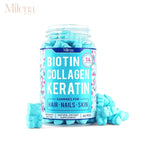Understanding Hyperpigmentation: A Deep Dive
Hyperpigmentation, the unwelcome appearance of dark spots and uneven skin tone, affects millions. It's characterized by an overproduction of melanin, the pigment giving skin its color. These darker patches often appear on the face, neck, and hands, significantly impacting self-esteem and confidence. But understanding its root causes is the first step toward reclaiming your radiant complexion. Let's explore the contributing factors:
- Sun Exposure: The sun's ultraviolet (UV) radiation is a primary culprit. UV rays stimulate melanocytes (melanin-producing cells), leading to excess melanin and dark spots. This highlights the importance of consistent sun protection in any hyperpigmentation treatment plan.
- Inflammation: Skin injuries like acne, eczema, or even minor cuts trigger inflammation, stimulating melanin production and resulting in post-inflammatory hyperpigmentation (PIH). Managing inflammation is crucial.
- Hormonal Changes: Fluctuations in hormones, especially during pregnancy (melasma) or menopause, influence melanin production, contributing to hyperpigmentation. Understanding these hormonal shifts is vital.
- Genetics: Family history plays a significant role; some individuals are genetically predisposed to hyperpigmentation. This highlights the importance of personalized treatment.
- Certain Medications: Some medications increase sun sensitivity, leading to hyperpigmentation. Always consult your doctor about potential side effects.
- Friction: Repeated rubbing or friction (shaving, tight clothing) can stimulate melanin production. Gentle skincare practices are essential.
- Age: As we age, our skin's ability to repair itself slows down, leading to increased susceptibility to hyperpigmentation. Age-appropriate skincare is crucial.
- Underlying Medical Conditions: In some cases, hyperpigmentation can be a symptom of an underlying medical condition. Consulting a dermatologist is paramount.
Effective Hyperpigmentation Treatments: A Comprehensive Overview
Numerous treatments effectively address hyperpigmentation, from gentle home remedies to advanced medical procedures. The best approach depends on the type, severity, location, your skin type, and overall health. Always consult a dermatologist for a personalized plan. Here are common methods:
Topical Treatments: A Gentle Approach
- Retinoids: Vitamin A derivatives accelerate cell turnover, gently exfoliating and fading dark spots. Excellent for acne-related hyperpigmentation.
- Hydroquinone: A bleaching agent inhibiting melanin production. Effective but typically used under a dermatologist's supervision.
- Azelaic Acid: Naturally occurring, anti-inflammatory, and skin-lightening. Suitable for sensitive skin.
- Kojic Acid: Derived from fungi, inhibits tyrosinase (melanin production enzyme). Often found in skin-lightening products.
- Niacinamide: Vitamin B3 reduces inflammation, improves skin barrier function, and evens skin tone.
- Vitamin C: A powerful antioxidant protecting against UV damage and promoting collagen production, which aids in skin regeneration.
- Tranexamic Acid: Inhibits plasmin, an enzyme involved in melanin production. Effective for melasma and PIH.
Professional Treatments: Advanced Solutions
- Chemical Peels: Chemical solutions exfoliate the skin, revealing brighter, even skin. Depth varies based on hyperpigmentation severity.
- Microdermabrasion: Gently exfoliates using a special instrument, improving skin texture and reducing hyperpigmentation.
- Laser Treatments: Concentrated light beams target melanin, breaking it down and improving skin tone. Different lasers cater to various hyperpigmentation types.
- Intense Pulsed Light (IPL): Broad-spectrum light targets melanin, improving skin tone and texture.
- Microneedling: Creates micro-injuries to stimulate collagen production and improve skin texture, which can help with hyperpigmentation.
Natural Solutions: Gentle Yet Powerful
Natural solutions complement professional treatments and provide gentle care. Two powerful options are:
Turmeric Kojic Acid Pads: Your Daily Dose of Radiance
Experience the transformative power of Turmeric Kojic Acid Pads. These pads expertly combine turmeric's anti-inflammatory and skin-brightening properties with kojic acid's melanin-inhibiting effects. This potent blend reduces dark spots, soothes irritated skin, and promotes an even skin tone. Suitable for all skin types, including sensitive skin, these pads are your daily companion for clearer skin. 
Key Benefits:
- Reduces the appearance of dark spots and hyperpigmentation.
- Soothes inflammation and redness.
- Promotes a brighter, more even skin tone.
- Suitable for all skin types, including sensitive skin.
- Easy to incorporate into your daily skincare routine.
Turmeric Kojic Acid Soap: A Cleansing Ritual for Brighter Skin
Elevate your skincare routine with Turmeric Kojic Acid Soap. This luxurious cleanser combines turmeric and kojic acid for a powerful yet gentle cleanse. Coconut oil and shea butter keep skin hydrated and soft. Use it twice daily for optimal results. 
Key Benefits:
- Brightens and evens skin tone.
- Fades acne scars and blemishes.
- Deeply cleanses and detoxifies.
- Hydrates and nourishes the skin.
- Gentle and effective for all skin types.
Sun Protection: Your Constant Companion
Regardless of your chosen treatment, consistent sun protection is paramount. UV radiation triggers and worsens hyperpigmentation. Protect your skin by:
- Using a broad-spectrum sunscreen (SPF 30 or higher) daily.
- Reapplying sunscreen every two hours, especially after swimming or sweating.
- Seeking shade during peak sun hours (10 a.m. to 4 p.m.).
- Wearing protective clothing (hats, long sleeves).
Patience and Persistence: The Cornerstones of Success
Hyperpigmentation treatment requires patience and persistence. Results aren't immediate; consistent effort is crucial. Be patient with your treatment plan; consistency is key. If you see no improvement after several weeks or months, consult your dermatologist for alternative options.
Lifestyle Factors: A Holistic Approach
Address hyperpigmentation holistically. Combine treatments with a healthy lifestyle: balanced diet, adequate hydration, and stress management. These factors significantly impact skin health and contribute to an even complexion.
Consult a Dermatologist: Personalized Guidance
Consult a board-certified dermatologist for personalized advice and treatment. They'll diagnose your hyperpigmentation type, recommend suitable treatments, and monitor your progress. Professional guidance ensures you're on the right path to achieving clear, radiant skin.
Conclusion: Embracing Your Radiant Future
Hyperpigmentation doesn't have to define you. By understanding its causes, employing effective treatments, and practicing consistent sun protection, you can significantly reduce the appearance of dark spots and achieve the clear, radiant skin you deserve. Patience, persistence, and a holistic approach are your keys to unlocking your skin's full potential. Embrace the journey to a brighter, more confident you!

